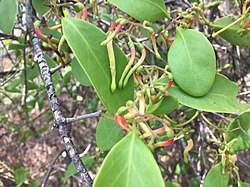Biology:Muellerina celastroides
| Muellerina celastroides | |
|---|---|

| |
| Scientific classification | |
| Kingdom: | Plantae |
| Clade: | Tracheophytes |
| Clade: | Angiosperms |
| Clade: | Eudicots |
| Order: | Santalales |
| Family: | Loranthaceae |
| Genus: | Muellerina |
| Species: | M. celastroides
|
| Binomial name | |
| Muellerina celastroides | |

| |
| Occurrence data from AVH | |
| Synonyms[1] | |
|
Dendrophthoe celastroides (Sieber ex Schult. & Schult.f.) Mart. | |
Muellerina celastroides, common names Banksia mistletoe and coast mistletoe,[3] is a hemiparasitic aerial shrub in the family Loranthaceae.[4] The species is endemic to New South Wales, Victoria and Queensland.[4][5]
Description
Muellerina celastroides is an erect or spreading plant which is smooth except for the inflorescence axis which is covered with minute, brown, densely matted woolly hairs.[6][7] The leaves are oblong to elliptic and 2.5–7 cm long and 15–25 mm wide, with a rounded apex and an attenuate base.[6][7] The inflorescence is a raceme of 1–3 pairs of triads, with the stems of lateral flowers being 3–6 mm long.[6][7] The calyx is entire and about 1 mm long.[6][7] The corolla in mature bud is 22–35 mm long.[6][7] The anthers are about 1.5 mm long, with the free part of filament being 8–13 mm long.[7] The fruit is pear-shaped, 7–11 mm long, and green grading to light red.[6][7]
Ecology
The most frequently recorded hosts on which M. celastroides grows are Allocasuarina, Banksia, and Eucalyptus species, but it frequently is found on exotics and on other mistletoes.[3] An inventory of host plants for Muellerina celastroides is given by Downey.[8][9]
Muellerina celastroides hosts the butterflies: Delias nigrina, Delias argenthona, Hypochrysops digglesii, Ogyris abrota, Ogyris zosine and Candelides margarita.[3][10]
Taxonomy
The species was first described by Franz Sieber in 1829 as Loranthus celastroides.[1][11] It was redescribed by van Tieghem in 1895 as Muellerina celastroides.[1][2]
References
- ↑ 1.0 1.1 1.2 1.3 "APNI: Muellerina celastroides". Australian Plant Name Index. https://biodiversity.org.au/nsl/services/rest/name/apni/63835/api/apni-format.
- ↑ 2.0 2.1 van Tieghem, P.E.L. (1895) Sur Les Loranthoidées De La Nouvelle-Zélande. ISSN 0037-8941 Bulletin de la Société Botanique de France 42(1): 23–30. doi:10.1080/00378941.1895.10830569 PDF (p.25).
- ↑ 3.0 3.1 3.2 Watson, D.M. (2011) Mistletoes of Southern Australia, CSIRO Publishing, Collingwood, Victoria
- ↑ 4.0 4.1 Quirico, A.L.. "Muellerina celastroides". PlantNET - New South Wales Flora Online. Royal Botanic Gardens & Domain Trust, Sydney Australia. http://plantnet.rbgsyd.nsw.gov.au/cgi-bin/NSWfl.pl?page=nswfl&lvl=sp&name=Muellerina~celastroides.
- ↑ Barlow, B.A. in George, A.S. (ed.) (1984), Loranthaceae. Flora of Australia 22: 90, Fig. 23B, Map 102
- ↑ 6.0 6.1 6.2 6.3 6.4 6.5 Barlow, B.A. (1984) Flora of Australia online: Muellerina celastroides. Data derived from Flora of Australia Volume 22 (1984), a product of ABRS, ©Commonwealth of Australia
- ↑ 7.0 7.1 7.2 7.3 7.4 7.5 7.6 PlantNet:Description of Muellerina celastroides (Quirico, A.L. 1992. Flora of NSW 3) Retrieved 17 October 2018.
- ↑ Downey, P.O. (1998) An inventory of host species for each aerial mistletoe species (Loranthaceae and Viscaceae) in Australia. (Cunninghamia 5(3) 685-720)
- ↑ Downey, P.O. (2004) A regional examination of the mistletoe host species inventory. (Cunninghamia 8(3) 354-361)
- ↑ Moss, J.T. & Kendall, R. (2016) The Mistletoes of subtropical Queensland, New South Wales and Victoria. Butterfly and Other Invertebrates Club Inc. Runcorn Queensland.
- ↑ Schultes, J.A. & Schultes, J.H. (1829,1830), Systema Vegetabilium Edn. 16, 7(2): 163, 1614, 1784
External links
- AVH: Occurrence data for Muellerina celastroides
- ANBG: Photo (M. Fagg) Muellerina celastroides in flower
- Photographs on Flickr of Muellerina celastroides
Wikidata ☰ Q15383163 entry
 |

